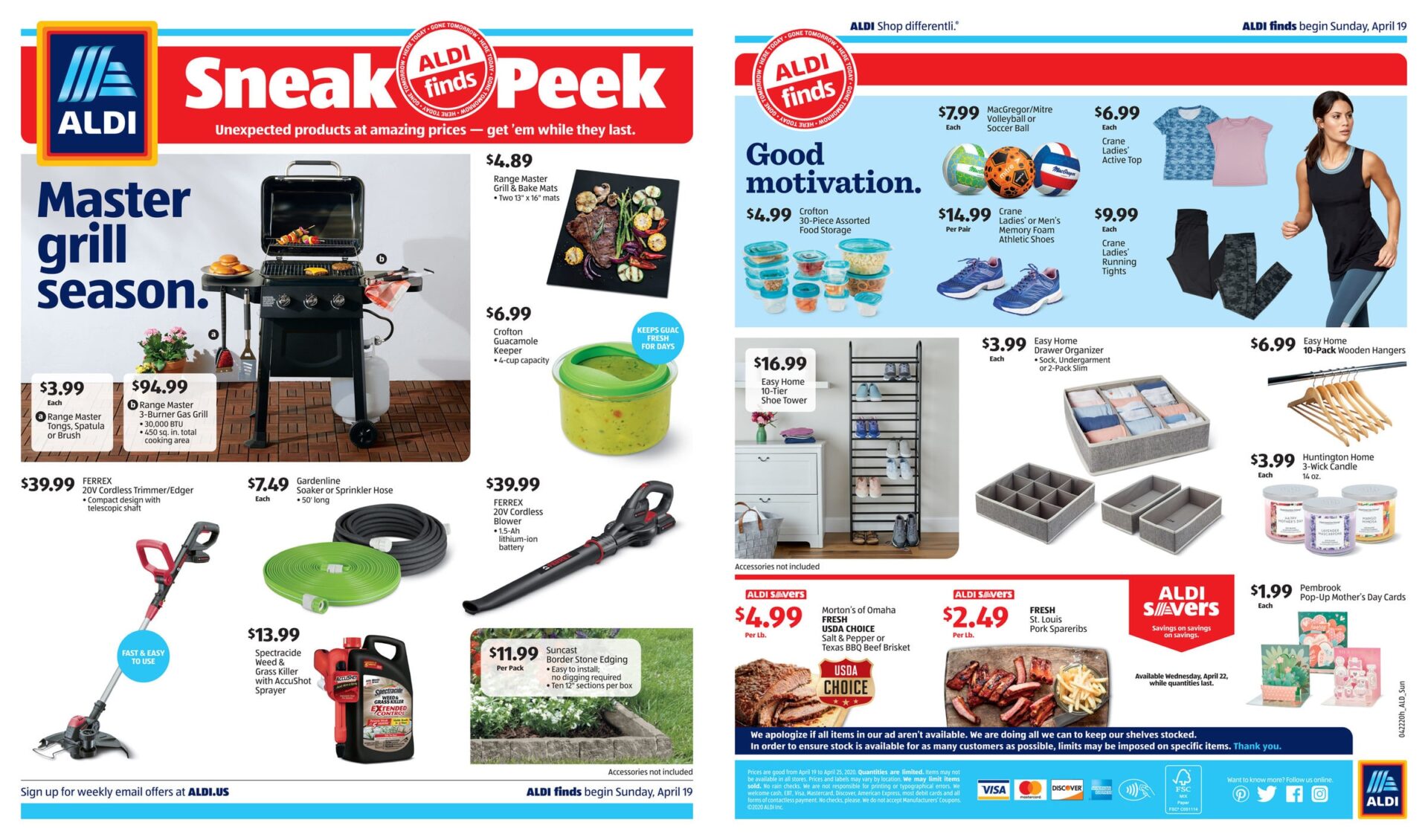 EDITOR’S NOTE: Edited sections on store size and bagging for clarity.
EDITOR’S NOTE: Edited sections on store size and bagging for clarity.
If you’ve been shopping at Aldi for a while, you probably developed a routine. You may have had an aisle you liked to start with (the middle aisle is popular) and you’d drift around from there.
Things have changed. On April 9th, Aldi instituted new limitations on its stores, including how many customers could get in and where they could go. This is on top of other store changes, including expanded hours for older and health-compromised people. We don’t know how long these limitations will be in place.
Nevertheless, people need to shop, and they may not want or be able to use Instacart. For people who still need to physically go to the store, we’ve assembled a few thoughts.
Try to Avoid Peak Times and Special Customer Times
This is true all the time, but it’s especially true now: certain times of day can get pretty busy. At the outset of these limitations, we discovered that store openings could be very busy, and that was before Aldi instituted special hours for vulnerable customers. Your store may be different, but depending on your area, you might want to avoid arriving right at opening. Also, on Tuesdays and Thursdays, the store is now open for vulnerable customers from 8:30 a.m. to 9:30 a.m. Likewise, we’ve found that later in the afternoon and the evening can also be busy.
Right now, we’re looking at doing our shopping a little after opening — say, 10 a.m. — or in the early afternoon — say, 1 p.m. Again, though, your store may be different.
Medical Professionals Get to Jump to the Front of the Line
If you are a medical professional, you can get in ahead of everyone else if you bring your work identification. (If you’re not a medical professional, be kind to them if they get to skip in front of you.)
Come Alone If Possible
Aldi has asked that customers come alone, although it has acknowledged that some people can’t do that, because they either have children or because they’re assisting a vulnerable person. Try to come alone if at all possible, but don’t fret if you can’t.
Be Prepared to Wait Outside
Aldi is limiting entry to roughly five customers for every 1,000 square feet. According to Aldi, an average store is about 22,000 square feet, with about 12,000 of that devoted to floor space, so that would indicate about 60 customers at any one time. Based on what Aldi fans are saying on social media, the number of customers allowed in may be different for each store, and we’ve seen reports of anywhere from 10 to 60 customers being allowed in at one time, with the average being more like 30-50. Either way, if there are a lot of customers there, you may have to wait for a little bit to get in.
You May Not Need A Quarter
In an effort to keep speed up and handling of objects down, many stores are having workers hand carts to shoppers as they enter and then collecting them back at the store after a customer has loaded their car and returned the cart. Because of that, you may not need your trusty quarter, although it never hurts to keep one around just in case.
For Best Results, Bring a List Organized by Aisle
One major change is that Aldi is making its aisles one-way. While we don’t think that will keep you from being able to double back to an aisle if you missed something, you’ll save yourself a lot of hassle if you know exactly where to find everything. To do that, we strongly recommend creating a shopping list organized by row.
In addition, we recommend using a handwritten or printed paper list if possible. We think this is wise for a lot of reasons, including the fact that 1) it makes it so you don’t need to touch or handle your phone in-store and 2) you can dispose of the list when you’re done.
You can easily make your own list, but we’ve mocked up two very simple list templates depending on the layout of your store:
You Might Consider Bagging Your Groceries At Your Car
We’re not exactly sure how every store will ultimately handle the bagging area, but there are a couple of good arguments for customers voluntarily bagging their groceries at your car. One reason is that it allows another customer into the store. Another reason is that it gets you into the open air where it may be less germy and easier to practice social distancing. You can get creative about bagging: we like to use laundry baskets, for example, rather than reusable bags that we have to launder or sanitize. Laundry baskets let us pack things up far more quickly, and we can easily disinfect them when we get home.
Do you have any other tips? Let us know in the comments.





Laundry basket idea and reminder to do bagging outdoors are both brilliant and helpful. Glad to be your subscriber, Ellis
In the Aldi store developement document https://corporate.aldi.us/fileadmin/fm-dam/real_estates/ALDI_Real_Estate_Flyer_9.17.13.pdf
It says
“stores are typically 16,400 square feet, with approximately 10,000 square feet of sales floor.”
The limit is based off retail floor space and the staff is included in the number. In Michigan, my state, the limit is 4 per 1000 sq ft. However, I think it may be up to the individual States to establish their number. So that works out to a max of 40 per store including the staff.
The last time I went, April 9, my store allowed sorting at the counter. They had all the carts unlocked so no quarter was needed. They try to not swap carts at checkout. My checker asked if it was ok with me to swap carts since I had a fair amount of items (I did shopping for two of my friends as well). To me the most difficult thing was the one way isles.
Please wear gloves and a mask when shopping.
When done shopping: Disinfect, with a wipe or alcohol wetted paper towel, the parts of your vehicle that you touched with you gloved hands. I also wipe my payment card, keys and quarter if used. Then remove each glove so that they are turned inside out. Dispose of in trash (my Aldi doesn’t have trash) or place used gloves in back of vehicle to dispose of later. DON’T toss them in the parking lot or cart. Disinfect hands thoroughly and THEN remove you mask last.
If you plan it out, you do not have to disinfect your reusable bags/totes.
The virus can transfer via surfaces, however it is not as effective as person to person transfer. Under typical conditions, the virus may survive on paper/fabric products for up 24 hours. Non-porous surfaces can be 72 hours (3 days). So if you bring your bags home and let them set for 3 days, the virus will no longer be viable. However, leaving ice cream out for 3 days isn’t a great idea. I suggest that you pack refrigerated/freezer items separately from other things. This way you can decontaminate those items before they go into your cold storage. If you don’t decontaminate them before you put them away, your freezer will actually preserve the virus and your fridge will extend the viability of the virus just like it does with food products. In theory, you could pull an item out of the freezer a year later and get infected.
If you need an item sooner (like dinner that night) also pack them separately so they can be decontaminated.
Like other pathogens, the virus can be killed at temps of 165F in the same way that properly cooking meat does. You can use your oven to decontaminate items, but keep the temp less than 200F to avoid boiling canned goods or increasing the chance of melting plastics. I put $500 from an ATM in the oven to sanitize it. Kind of scary, but fun too.
The simple way is to shop three days before you need pantry items. You can leave items in your garage, trunk of car, closet, wherever you want to establish a quarantine zone.
So the basic rule is: If no one has touched something for 3 days or more, you can’t get the virus from it.
Thanks for your thoughts. I did add a bit of clarification to the post, especially regarding store size.